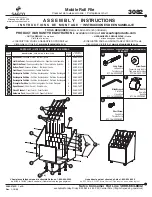
Section BXM‐301‐10H‐20A
030‐101901 Rev. A
R
5
1608IARA
knock‐out near the center rear of the Boxer‐30 floor is for bat
tery cable ingress and egress (or for Network cables) when an
optional battery cabinet is mounted below the Boxer‐30 cabi
net. Provided along the right side of the cabinet floor are
multiple intact knock‐outs, for easy Network and Customer
cable access; the front‐most are typically for customer cable ac
cess, and the rear‐most knock‐outs are typically for Network
cable access. The knock‐out sizes and quantities are shown in
Table 1, Figure 9, and Figure 21. Do not remove a knock‐out
unless it is absolutely necessary to do so for cable ingress and
egress, and use either tight‐fitting rubber grommets or liquid‐
tight fittings, or other proper and approved knock‐out hole
sealants, to assure the best internal air quality and weather‐re
sistance. Always use proper and company‐approved tools to
remove knock‐outs.
‐ KNOCK‐OUT REMOVAL NOTE ‐
Always remove knock‐outs where holes are desired before
mounting the cabinet or the optional battery box, regardless of
the type of knock‐out and the order of the mounting steps.
2.1.2.7
AC Conduit Fitting
A 1/2” AC conduit fitting is provided on the exterior bottom
surface of the cabinet (see Figure 8) through a knock‐out hole
near the back right corner, to facilitate conduit attachment. In
side the cabinet, the fitting is connected to an AC outlet box
immediately above it inside the cabinet.
2.2
Interior Features
The interior cabinet features are described hereunder.
2.2.1
Internal 19” Rack Channels
Two adjustable rack channels inside the cabinet provide
30‐RU‐high 19” relay rack mounting for equipment that is to
be mounted in the cabinet. Each adjustable channel is factory‐
installed so approximately 5” of equipment space is available
from the inside of the closed front door to the channel (for up
to a 5” equipment projection), and approximately 12” of equip
ment space is available behind the channel to the rear cabinet
wall. The channels can be moved forward 2” or backward 3”, if
a few additional inches of equipment depth is needed at either
the front or back of the channel. Seven slots are provided for
seven channel positions (see Figure 2). Each rack channel also
contains predrilled holes, with standard hole spacings (either
1”, 1.75”, or 2” rack hole patterns), to mount customer‐sup
plied equipment in the cabinet. Network equipment up to 30
Rack Units (30 RUs = 52.5”) high can be mounted on the inter
nal rack inside the cabinet, either as a single piece or multiple
pieces of equipment.
2.2.2
Door Sensor Switch
A door sensor switch is located at the bottom right corner of the
cabinet door opening (Figure 12). A wire stub is provided to tie
the alarm cabling into the customer‐supported equipment.
When the switch is connected, to temporarily disable the sen
sor, pull out the cylindrical door switch actuator until it clicks.
To re‐activate the sensor, either gently push the actuator back
in until a click is heard, or simply close the cabinet door.
2.2.3
Temperature Alarm Probe
A temperature alarm probe is provided in the upper, left, rear
corner of the Boxer‐30, attached to a bracket, as shown in
5” in
12”
Customer
Knock‐outs
2 Network
Knock‐outs
rack
channel
of rack
channel**
TOP VIEW
Rack Channel
14.5”
2”
2”
** Factory default position.
2”
(adjustable)
*
2”
Channel is adjustable to 7 positions.
Knock‐out for cables from optional battery box or for Network
AC duplex outlets
GFI Duplex Outlet
behind
front
(uses 1 knock‐out)
Figure 8.
Exterior Bottom Isometric View of Cabinet
2” Knock‐outs
Factory‐installed fitting, for
1/2” AC conduit, installed
through 1.125” hole
Knock‐out typically used as access for
optional battery cable (when used with a
battery box) or for Network cables
Figure 9.
“See‐Through” Top View of Cabinet, Door Off
Ground Plate
Door Switch
Assembly
Knock‐out (1 of 5) for at
taching a battery box
See Figure 21 for a bottom view with
dimensions and knock‐out sizes
Remove and align the
5 small knock‐out
holes in the Boxer‐30
with the holes in the
battery box (see
knock‐out sizes and
dimensions).
See the battery box
documentation for
more information.
Figure 10. Aligning Boxer‐30 Knock‐outs/Mounting Holes
Mounting on a
battery box
Ö
Ö
ÖÖ
ÖÖ
ÖÖ
ÖÖ




































